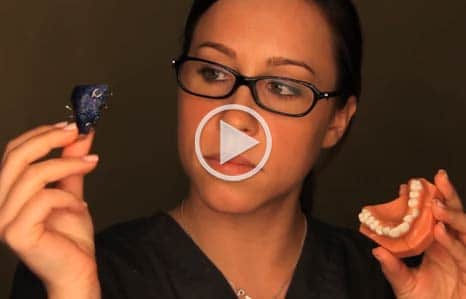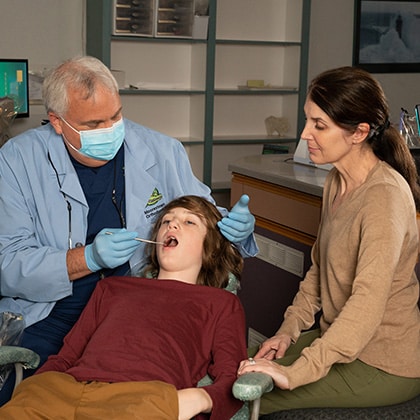When dental braces are finally removed, the “retention” phase begins for most individuals. The objective of this phase is to ensure the teeth do not regress back to their previous position. A retainer will be used to maintain the improved position of the teeth. A retainer is a fixed or removable dental appliance which has been custom-made by the orthodontist to fit the teeth. Retainers are generally made from transparent plastic and thin wires to optimize the comfort of the patient.

Retainers are worn for varying amounts of time, depending on the type of orthodontic treatment and the age of the patient. Perseverance and commitment are required to make this final stage of treatment a success. If the retainer is not worn as directed, treatment can fail or take much longer than anticipated.
What Types of Retainer are Available?
There are a variety of retainers available, each one geared towards treating a different kind of dental problem. The orthodontist will make a retainer recommendation depending on the nature of the original diagnosis and the orthodontic treatment plan.
The following are some of the most common types of retainers:
- Hawley retainer – The Hawley retainer consists of a metal wire on an acrylic arch. The metal wire may be periodically adjusted by the orthodontist to ensure the teeth stay in the desired position. The acrylic arch is designed to fit comfortably on the lingual walls or palate of the mouth.
- Essix – The Essix retainer is the most commonly used vacuum formed retainer (VFR). A mold is initially made of the teeth in their new alignment, and then clear PVC trays are created to fit over the arch in its entirety. The advantage of these retainers is that they cover more of the tooth surface and this helps to prevent relapse. The disadvantage of this type of retainer is that they can stretch or deform over time. This can permit movement of the teeth.
- Reinforced Essix Retainer – Our office uses a unique process that adds hard acrylic to the inside or lingual surface of the retainers. This hard acrylic does not deform. This design combines the durability of the Hawley retainer with the greater tooth coverage of the Essix or VFR retainer. It is a little more work to produce these retainers. However, we believe that being able take advantage of the best aspects of the Hawley and Essix VFR retainers is worth the extra effort.
- Fixed retainers – A fixed retainer is similar to a smooth wire that is affixed to the lingual or tongue side of a few teeth. Usually, a fixed retainer is used in areas where the orthodontist is especially concerned that there may be tooth movement or relapse. They may also be recommended and used with younger patients, where ideal cooperation with wearing retainers can be of concern.
Caring for Retainers
There are a few basic things to consider for proper use and maintenance of your retainer.
- Don’t lose the appliance – Removable retainers are very easy to lose. It is advisable to place your retainer in the case it came in while eating, drinking, and brushing. Leaving a retainer folded in a napkin at a restaurant or in a public restroom is very common and can be a very costly mistake. It is probably the number one reason that retainers are lost. A good recommendation for your retainers is to keep them “in your face or in your case”. If you put the retainers in your case as soon as you take them out, you can then put in in a pocket or purse and will not lose them.
- Keep the appliance away from dogs – If you are a dog lover, that’s great. However, dogs are probably the second most common reason that retainers are lost or broken. Your beloved dog will see it in your mouth, smell your saliva on it, and think that it is a wonderful thing to chew on. We have had patients whose dogs have gotten into dresser drawers, and even destroyed L.L.Bean backpacks, just to get to a retainer. When you are at home and not wearing your retainers, we recommend keeping them high and in a place where your dog cannot get them.
- Don’t drink while wearing a retainer – It is tempting to drink while wearing a retainer because of the unobtrusive nature of the device. However, excess liquid trapped under the trays can vastly intensify acid exposure to teeth, increasing the probability of tooth decay.
- Don’t eat while wearing a retainer – It can be difficult and awkward to eat while wearing a removable retainer and it can also damage the device. Food can get trapped around a Hawley retainer wire or underneath the palate, causing bad breath. When worn on the upper and lower arches simultaneously, VFR retainers do not allow the teeth to meet. This means that chewing is almost impossible.
- Clean the retainer properly – Removable retainers can become breeding grounds for calculus and bacteria. It is essential to clean the inside and outside thoroughly as often as possible. Retainers can be cleaned with a toothbrush. Our advice is to use your old toothbrush that is no longer being used to clean your teeth. That way you will not prematurely wear out the toothbrush that is currently being used for your teeth. To help remove the calculus or tarter from your retainers, as well as disinfect them, periodic use of denture cleaner or a specialized retainer cleaner is recommended.
- Wear the retainer as directed – This phase of treatment is critical. The hard work has been done; the braces are off, and now it is tempting not to wear the retainer as often as the orthodontist recommends. Retainers are needed to give the muscles, tissues, and bones time to stabilize the teeth in their new alignment. Failure to wear the retainer as directed can have regrettable consequences, such as teeth returning to their original position, added expense, and lost time. Wearing retainers really is the easy part. Just wear them as directed to help keep that great healthy smile that you worked so hard to achieve.






